Cobb safety village teaches youth life skills
The recreation of the Marietta Square in the middle of the Cobb County Safety Village, sponsored by the Malon D. Mimms Company and dedicated to the children of Cobb County. The plaque proudly displays the village’s motto: “Tell me and I may forget. Show me and I may remember. Involve me and I understand.”
February 9, 2016
A light buzz of activity permeates the eight acres off of Al Bishop Road in Marietta, Georgia. Traffic lights flip from green to red, children race around paved streets, and firemen and police officers educate on home safety all under the summer sun. Filled with community investors, interactive explanations, and safety education on every possible topic, the Cobb County Safety Village thrives.

Inside Sparky’s house, a fake fire blazes in the fireplace. The house aids in the education of fire safety by exemplifying specific fire hazards children may run into.
As one of 20 in the entire country, the Safety Village exemplifies the success of the health and safety education system. Sitting on eight acres of government-owned land, the village recreates Cobb County in a full-sized village, complete with buildings based off of local businesses, working streetlights and paved roads, and a 27,500 square foot educational building. Run by the Cobb County Safety Village Foundation, the village operates to teach the community about safety in all aspects of their lives, from fire prevention to how Colonial Pipelines’ transportation of gasoline, through interactive modules and experienced instructors.
The Safety Village broke ground in 2008, but the idea behind it reaches back farther.
“In 1978, the State of Georgia mandated that fire and safety education needed to take place,” Safety Village director Allison Carter said. “At that time, Cobb Fire said we will take on the fire education division and started going out to every first, third, and fifth grade classrooms. As they started that, Cobb County was growing so quickly that we couldn’t and spending so many county dollars sending off firefighters to schools and they couldn’t reach everybody. So in 1988 our board said ‘You know what, prevention education is working but let’s see what other up-and-coming cities are doing and how they are being more effective.’ That’s when our fire chief at the time put together a group, started researching, and came across this concept.”
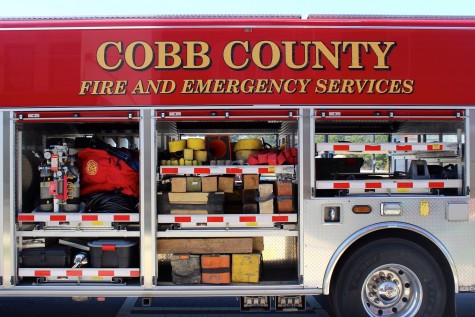
A fire truck parked right in front of the faux Marietta Square shows off its equipment. Firefighters from Cobb County Fire and Emergency Services serve as the instructors for the Safety Village, along with local law enforcement officers.
Safety villages began cropping up in the early 2000s, growing from there.
“There are less than 20 in the United States, and about 18 in Canada, and the idea is that you bring everybody under one roof,” Carter said. “Not only do we teach fire and life safety in the state-mandated education, but we also teach so much more. It’s all hands-on, interactive learning. We are putting them in a scenario or situation just like if they were in their own home and how would they get through.”
By educating every kindergartener in school, and each second and fourth grader at village, the instructors educate approximately 20,000 kids during each school season. They also include senior citizen education over the summer. Each patron takes a specific tour through the village to begin their safety learning experience.
A City of Safety
The tour of the safety village starts by pairing students with either a firefighter or a law enforcement officer. These experienced community member become the instructors and take the students through eight twenty-minute modules.
The tour starts at Sparky’s firehouse. The house explains fire hazards and how to craft an escape plan, as well as poisonous substances and medicine safety. For senior citizens, the house teaches cooking and medicine safety, home security, and ways to prevent trips and falls. By taking both second and fourth graders through the house, the village covers the science of fire, poison control, non-microwaveable materials, water burns, stove safety, and more home hazards. Each grade also plans out their escape route in case of a home fire.
“We go through escape plans in full scenario,” Carter said. “So the lights go out, the alarm goes off, the room fills with smoke, and the students have to fall, find a wall, and crawl out. Once they get into the bedroom, we talk about a second evacuation. As our instructors are speaking, the door to the room will fill with water. As our students make their way over to the door, the water heats up and students can feel the hot door. They then talk about evacuation through the window, and using certain materials to exit out, as well as fire ladders. They all then get to exit out of the window. Once everybody is outside we talk about our family meeting spot and every student calls into 911 and we go through all of the questions they would be asked.”
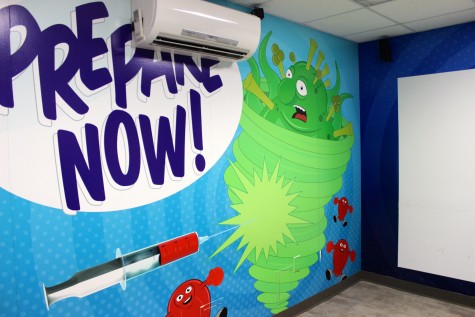
Inside the Cobb and Douglas Public Health building, an interactive screen and projector involve kids in washing their hands and evading sickness.
The memorable experience of reenacting fire escapes sticks with children after they leave.
“I loved the safety village. My favorite part was being in the house that filled up with smoke and then we got to climb out a window. It was fun and I would definitely recommend students go,” Cobb County student Erin Wilford said.
Next, the students move through police safety classrooms where they do explanations of gun safety and the latchkey program, for kids who come home to an empty house. Second graders stop by a recreation of The Strand theater in downtown Marietta to take part in a puppet show on water safety. Fourth graders head straight outside to learn pedestrian safety, and get to drive electric cars to learn the rules of the road.
The tour moves around the square and into the Cobb EMC building next, which incorporates interactive games and technology to explain the generation of electricity and electrical hazards.
“When we started doing all of this, Cobb EMC said they totally supported this idea but they didn’t want to just put a building with a name on it,” Carter said. “They wanted it to actually do something and so they started the idea of this interactive education. In the Cobb EMC building we go through the path of electricity, how it is generated and gets to your home. Then we go through all twelve electrical hazards, including not throwing things at electrical equipment, and more. One of the nice things about having police and fire as their instructors is that they’ve pretty much all been on a call that had to do with one of these hazards so they have stories they can tell the kids to further explain.”
Other buildings, including Cobb and Douglas Public Health and Colonial Pipelines, took the same idea and ran with it.
“Colonial Health got a grant from the CDC to do interactive modules in their building,” Carter said. “Most villages can differ in size but they all have buildings that create their streets and they just have a name on them. We have kind of taken that to the next level.”
Students then pass by recreations of Kennesaw Mountain and downtown Atlanta’s Mable House, as well as a seating area for crowds. They finish off the tour by visiting a school bus for bus safety and then head back inside.
A Look into the Future
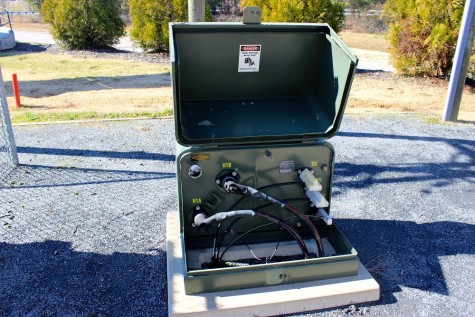
Outside the Cobb EMC building, the company recreated a transformer’s makeup to explain the danger it poses. “We ask all of our kids what they use this green box for, and they always say ‘Third base!’ and we all go ‘No!’ Then we explain to them what transformers do and how you have to watch out for rodents who will chew off the protective coating on the wires,” Safety Village director Allison Carter said.
The Cobb County Safety Village broke ground in 2008, but developments continue to arise. The foundation takes inspiration from the success of other villages around the country.
“One of the great things that our county did was that they put together a task force to go up and view other safety villages when they were first building. The task force was comprised of county government, both school systems, and then businesses including WellStar Public Health and Cobb EMC,” Carter said.
As the village continues to expand, a number of new businesses will create their presence in the town. The commercial area lines Al Bishop road, currently including the Kennesaw Depot which will be finished out to teach train safety. In the future, the village looks forward to a pet store, an insurance company, a Walmart, a Bluebird bus stop, a Home Depot, and a grocery store chain. Each would educate on a different topic of safety integrated into the curriculum. Furthermore, Carter plans on building a new fire and police building outside, a plaza for restrooms, a school building, a bank, and, with luck, a mini Braves stadium.
“The idea is that we are going to open to the public on the weekends, so you would be able to bring your kids through these new interactive buildings. Once I have restrooms in a plaza, then we can open to the public. All of our interactive safety buildings will be open and they have loop reels and games to educate,” Carter said.
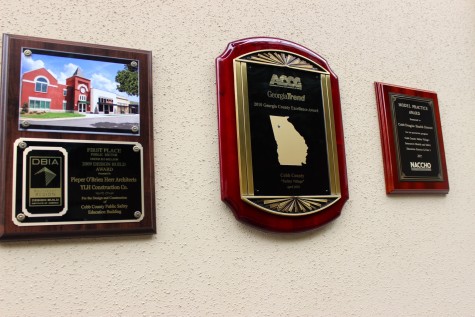
The Cobb County Safety Village displays its awards, including the 2009 Design Build Award, the 2010 Georgia County Excellence Award, and the Model Practice Award from the National Association of Counties.
The village also looks forward to expanding its residential sector with new sustainable technology.
“Walton Communities built our current two-story apartment complex and we have space for three more homes,” Carter said. “I am talking with one of the local builders to build another one and then the Weather Channel will come and finish it out so we can educate on tornadoes and weather safety. I would love to have one house that is completely sustainable from the ground up, so I am working with Southface on what would that look like and where to start. And yesterday I had a group come out and say that it would be really cool to retrofit a house for our adult seniors and teach that safety. “
While the Cobb County Safety continue to evolve, the entire community can look forward to a safe and fun place to learn about safety in every aspect of life.
“Our philosophy is simple,” Carter said. “Tell me and I will forget, show me and I may remember, involve me and I will learn for a lifetime.”



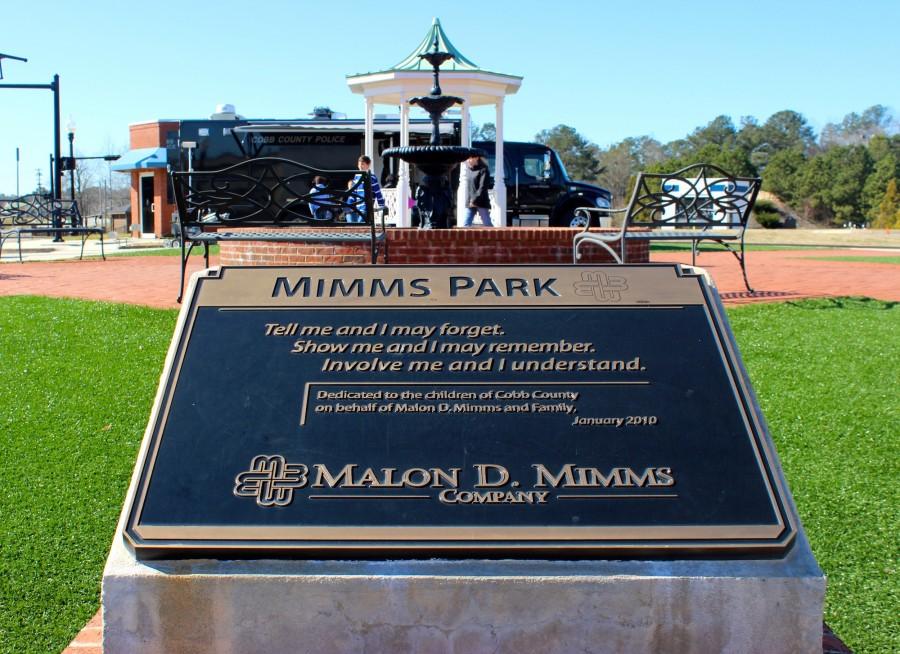

Carolyn Colyar • Feb 11, 2016 at 8:55 AM
Nice article, Kat! We here at Cobb EMC are honored to be a part of such a great initiative!